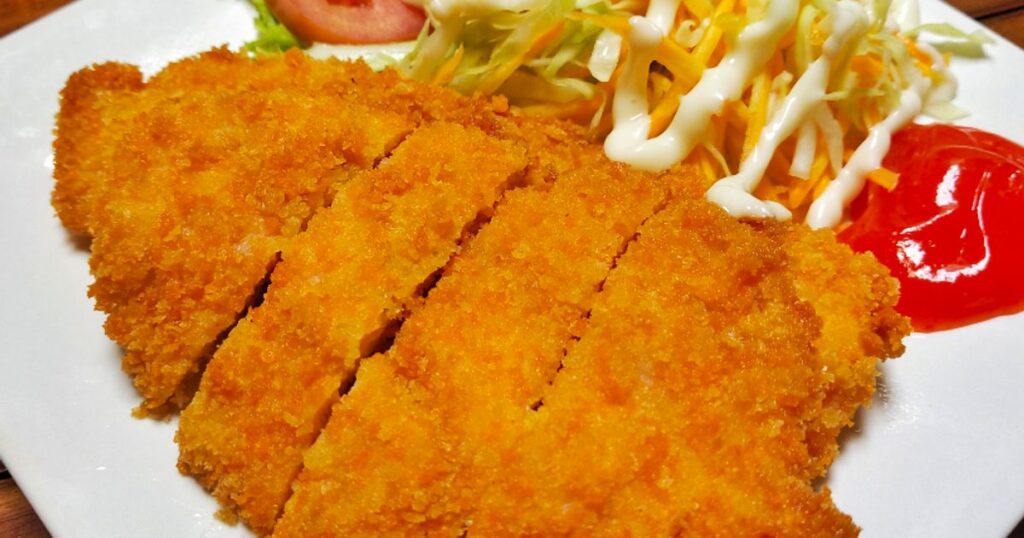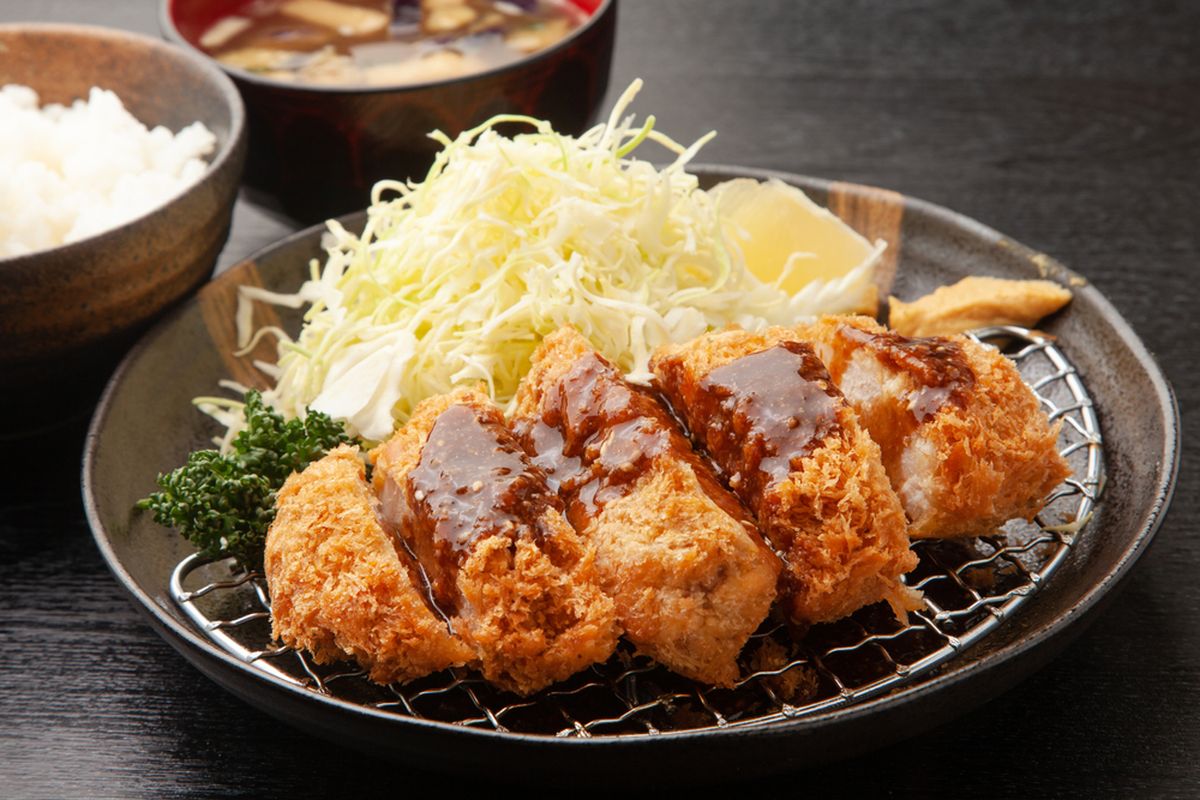Chicken Katsu, or Chikin Katsu (チキンカツ), is a globally beloved Japanese dish.1 A cousin to the original tonkatsu (pork cutlet), this dish is celebrated for its incredibly crunchy exterior and tender, juicy chicken inside.2 It’s a prime example of yōshoku—Japanese cuisine influenced by Western cooking—yet it has developed a uniquely Japanese identity, becoming a staple in bento boxes, curry houses, and family dinner tables worldwide.
The Story of the “Katsu”
The name katsu is a shortened form of katsuretsu, the Japanese phonetic transcription of the English word “cutlet.”3
The concept of breaded, deep-fried meat arrived in Japan during the Meiji Restoration in the late 19th century. Initially, katsuretsu was made with beef, inspired by French or European veal cutlets.4 However, Japanese chefs innovated, and in 1899, a restaurant in Tokyo created the famous Tonkatsu (pork cutlet).5
Chicken Katsu followed as a natural, lighter variation, especially popular for those who prefer white meat. Its enduring appeal lies in the use of a special Japanese breadcrumb called panko.6
The Panko Difference
The secret to a truly great katsu is panko.7 Unlike regular breadcrumbs, panko is made from bread baked using an electric current, resulting in a crustless white bread that is then coarsely ground into flakes.
- Crispier Texture: Panko flakes are larger and airier, creating a light, shatteringly crisp crust that resists absorbing too much oil.
- Unique Look: When fried, panko gives the katsu its iconic, jagged, and golden-brown appearance.
Paired with a savory-sweet Tonkatsu Sauce and a bed of thinly shredded cabbage to cut the richness, Chicken Katsu is a harmonious, satisfying meal.

Authentic Chicken Katsu Recipe
This recipe is simple, focusing on the correct technique and the use of panko for maximum crispiness.
Yields: 2 servings
Prep Time: 15 minutes (plus 30 mins marinating)
Cook Time: 10 minutes
I. Ingredients
A. The Chicken
- 2 pieces Boneless, skinless chicken breast fillet (about 180-200g each)8
- $1/2$ tsp Salt9
- $1/4$ tsp Black pepper powder10
- $1/2$ tsp Garlic powder (optional)
- 1 Tbsp Cooking oil (for coating)
B. The Coating (Dredging Station)
- $1/4$ cup All-purpose flour
- 1 large Egg, beaten lightly11
- 1 cup Japanese Panko breadcrumbs
C. For Frying
- 500 ml Vegetable oil (or enough for deep frying)
D. Serving Suggestions
- Shredded white cabbage12
- Steamed Japanese rice
- Tonkatsu Sauce (see quick recipe below)
- Mayonnaise (optional)13
II. Instructions
1. Prepare the Chicken (The Cutlet)
- Slice and Tenderize: Slice each chicken breast horizontally, creating two thinner fillets. Place each fillet between two sheets of plastic wrap or in a plastic bag. Gently pound the chicken with a meat mallet or a rolling pin until it is about $1/2$-inch thick. This ensures even cooking.
- Marinate: Season both sides of the chicken fillets evenly with salt, pepper, and garlic powder (if using). Lightly rub with 1 Tbsp of cooking oil to help the seasonings adhere. Let it rest for 15-30 minutes at room temperature.
2. Coat with Panko
- Set up Stations: Prepare three separate wide plates or shallow bowls: one with all-purpose flour, one with the beaten egg, and one with the panko breadcrumbs.
- Coat:
- Flour: Dredge the seasoned chicken fillet in the flour, shaking off the excess.
- Egg: Dip the floured chicken into the beaten egg, making sure both sides are fully coated.
- Panko: Place the chicken in the panko and firmly press the panko onto all surfaces. Gently pat the cutlet to ensure the crumbs are tightly packed—this is key to preventing the crust from separating during frying.
3. Deep Fry for Crispiness
- Heat Oil: Heat the vegetable oil in a deep pot or wok to $170^\circ \text{C}$ ($340^\circ \text{F}$). The oil must be hot enough to fry quickly but not burn the panko.
- Fry: Carefully place the chicken katsu into the hot oil. Do not overcrowd the pan. Fry for about 4-5 minutes, flipping once, until the panko is golden brown and extremely crisp.
- Check Doneness: Use a thermometer to check the internal temperature of the thickest part of the chicken, which should be at least $74^\circ \text{C}$ ($165^\circ \text{F}$). If the outside is dark but the inside is not cooked, lower the heat slightly and continue frying.
- Drain: Remove the katsu and place it on a wire rack or paper towels to drain excess oil.
4. Serve
- Slice: Place the katsu on a cutting board. Using a sharp knife, slice the chicken katsu into thick, easy-to-eat strips.
- Plate: Arrange the sliced katsu on a plate with a generous mound of shredded cabbage and steamed rice. Serve immediately with Tonkatsu Sauce for dipping or drizzling.
Quick Tonkatsu Sauce (A Simple DIY)
If you don’t have store-bought Tonkatsu sauce, you can whip up a flavorful substitute at home using common pantry ingredients.
Ingredients
- 4 Tbsp Ketchup (Saus Tomat)14
- 2 Tbsp Worcestershire Sauce (Kecap Inggris)15
- 1 Tbsp Soy Sauce (Kecap Asin)16
- 1 Tbsp Granulated Sugar
- 1/2 tsp Garlic powder (optional)
Instructions
- Mix: Combine all ingredients in a small bowl.
- Whisk: Whisk until the sugar is completely dissolved and the sauce is smooth.
- Taste Test: Adjust the flavor to your preference: add more sugar for sweetness, more Worcestershire for tanginess, or a dash of black pepper for spice.
- Serve: Use as the perfect savory-sweet counterpoint to your crispy Chicken Katsu.


Leave a Reply